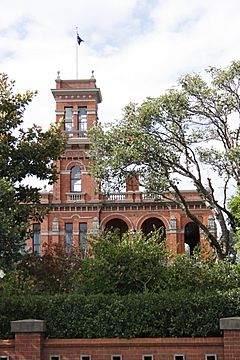Raheen, Kew facts for kids
Quick facts for kids Raheen |
|
|---|---|

Raheen viewed from the street
|
|
| General information | |
| Status | Complete |
| Type | Mansion |
| Architectural style | Italianate |
| Location | Kew, Melbourne, Victoria, Australia |
| Coordinates | 37°48′19″S 145°01′00″E / 37.8053°S 145.0167°E |
| Construction started | 1870 |
| Client | Edward Latham |
| Owner | Pratt family |
| Design and construction | |
| Architect | William Salway |
| Other designers | Egidio Lunardon (garden) |
| Known for | Home of Daniel Mannix and other Catholic Archbishops of Melbourne |
| Renovating team | |
| Architect | Glen Murcutt |
| Renovating firm | Bates Smart McCutcheon |
| Other designers | Jane Dennithorne (garden) |
| Main contractor | Kane Constructions |
| Official name: Raheen' | |
| Type: | Heritage place |
| Designated: | 14 July 1982 |
| Reference #: | 623 |
| Category: | Residential buildings (private) |
| Victorian Heritage Register (VHR) Number: | H0515 |
Raheen is a very old and important mansion (a large, grand house) in Kew, a suburb of Melbourne, Victoria, Australia. It's located at 94 Studley Park Road. The house was built in the 1870s. Its name, Raheen, means "little fort" in the Irish language.
This beautiful building is listed on the Victorian Heritage Register. This means it's officially recognized as a special historical place. Today, Raheen is owned by the Pratt family. It is the main home in Australia for Anthony Pratt.
Contents
History of Raheen Mansion
The building of Raheen started in 1870. Later, in 1884, more parts were added to the house. The famous architect William Salway designed it. It was first built for Edward Latham, who owned the Carlton Brewery.
Early Owners and Design
After Edward Latham, Sir Henry Wrixon owned Raheen. He was a very important lawyer in Melbourne. The house was built in a style called Italianate. This style often includes features like tall towers and arched windows.
Raheen has two main floors and a tall, four-story tower above the entrance. It also has a smaller, single-story part. The house is made of red brick with special cement decorations. The gardens, fences, and gates are still like they were long ago. Inside, you can still see the original staircase, library, ballroom, and iron stairs in the tower.
From Church to Private Home
In 1917, the Roman Catholic Archdiocese of Melbourne bought Raheen. It became the official home for the head of the Catholic Church in Melbourne, Archbishop Daniel Mannix. Four other Archbishops also lived there after him.
In 1981, the Church sold the property. It then became a private home again.
The Pratt Family and Renovations
In 1981, a well-known Australian businessman named Richard Pratt and his family bought Raheen. Richard and his wife, Jeanne, made many changes to the house and gardens. They added a new part designed by the famous architect Glen Murcutt.
Sometimes, the house and gardens are opened to the public for special charity events. After Richard Pratt passed away in 2009, his son, Anthony, started more renovations in 2016. Raheen is considered a very valuable property.
Why Raheen is Important
Raheen is very important to the State of Victoria because of its history and its amazing architecture.
Historical Importance
Raheen is historically important for a few reasons:
- It was home to important businessmen like Edward Latham and Sir Henry Wrixon. This shows how important their businesses and jobs were in Melbourne in the 1800s. It also shows how a grand home was a sign of success back then.
- It was the home of the Catholic Church's leaders in Melbourne for many years. This shows how important the Church and its leaders were to the Catholic community.
- Archbishop Daniel Mannix lived here. He was a very influential person in the Melbourne Archdiocese. He also played a big role in Melbourne's public discussions, especially during the First World War when people were debating if young men should be forced to join the army.
Architectural Importance
Raheen is also important for its unique design.
- It combines red brick with cement decorations in a special way.
- The house shows excellent design and beautiful features of the Italianate style.
- Its inside features and garden design are also considered very well done.

